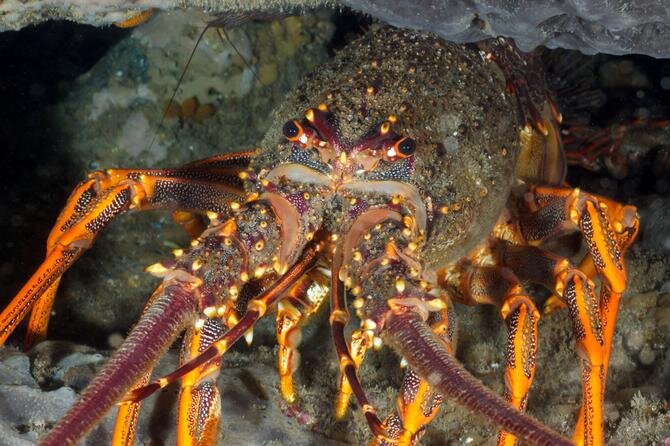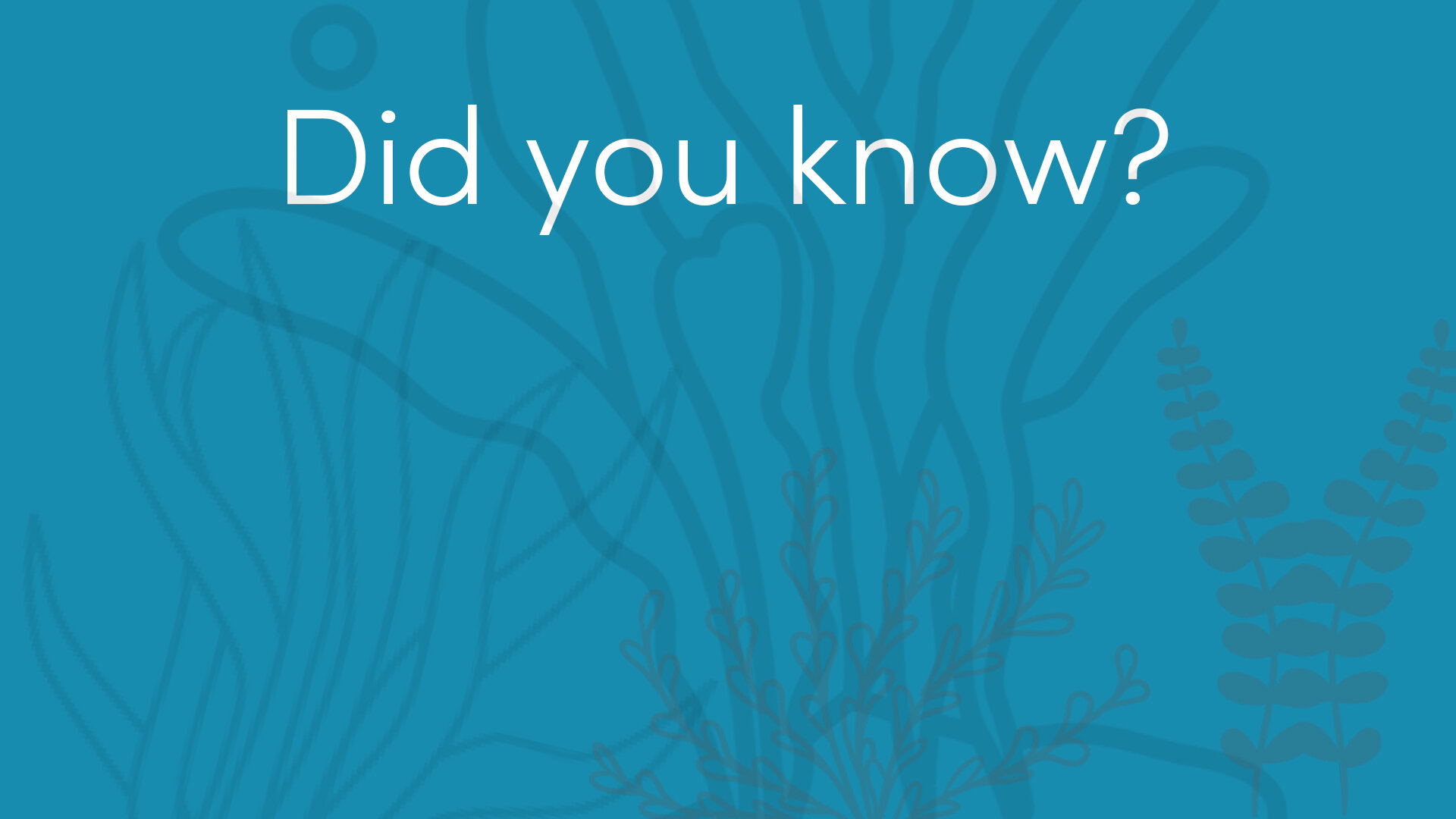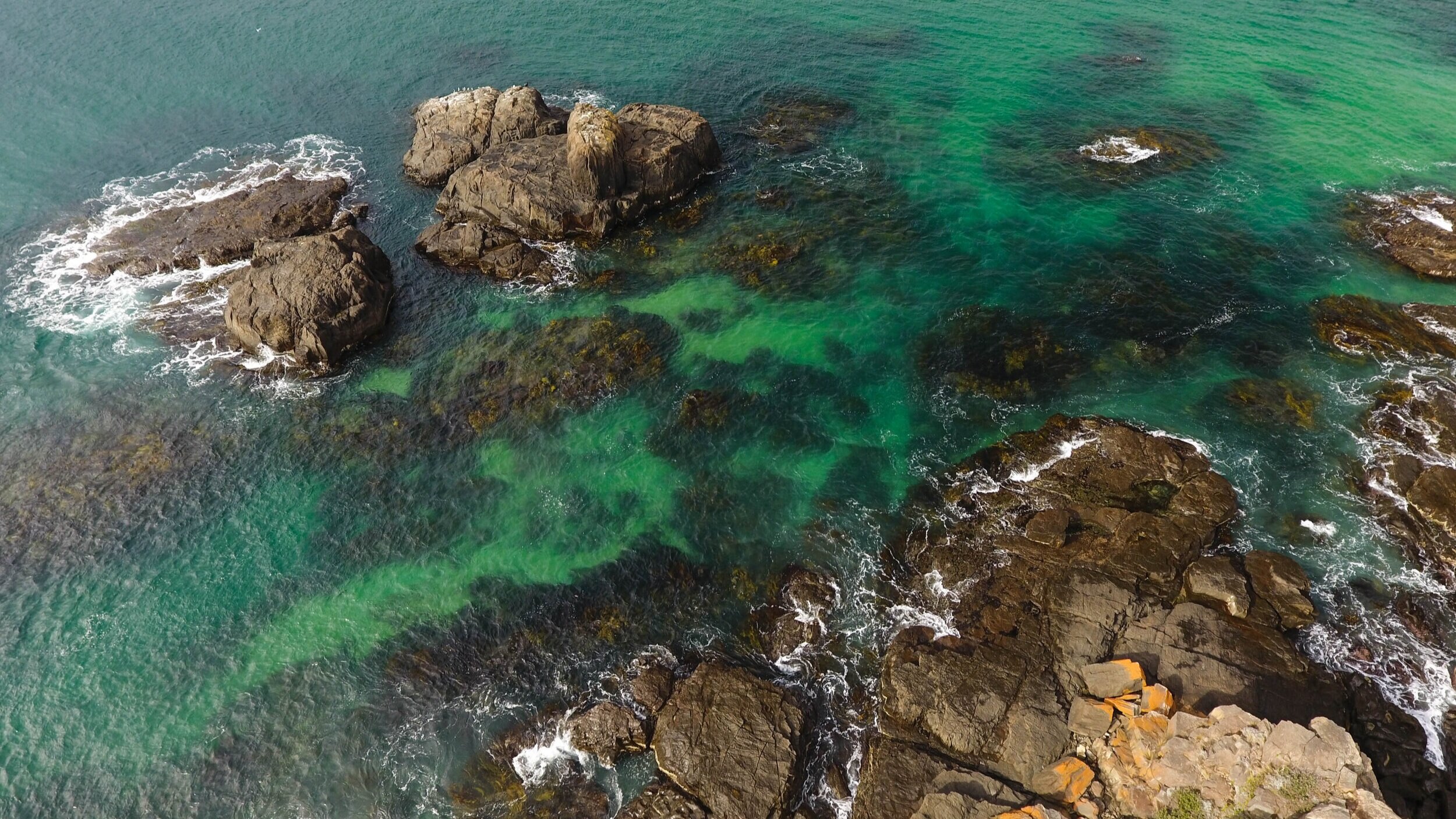giant kelp: CANOPY FORMING FORESTS
Fast growing habitat formers
Giant kelp (Macrocystis pyrifera) are an iconic canopy forming seaweed that can grow over 35 metres long and up to half a metre each day.
Just like the golden kelp, giant kelp is also a foundation species.
Like trees in a forest, giant kelp modifies the environment and the resulting conditions favour a huge diversity of other species.
The physical effects of kelp forests are that they:
• slow water movement providing a sheltered habitat for animals on the sea floor.
• shade the seabed, but still permit a diverse under-storey of low lying species beneath the canopy.
• provide a habitat for myriad mobile and sessile (non-mobile) animals across the levels of the forest canopy, from the upper canopy to mid waters and within the holdfast.
Dampening the drift
Because giant kelp slows down the movement of water, drifting larvae tend to be retained within the reef system, facilitating larval settlement on the seabed. This has been shown to enhance rock lobster recruitment to Tasmanian coastal reefs.
An exciting place to explore
We asked Professor Craig Johnson from the University of Tasmania: What do you see when you are diving in a kelp forest?
"I've been working on kelp forests in different parts of the world for about 40 years all up and I never get sick of it. They're really magnificent places to work, aesthetically… especially the giant kelp forests.
It's a wonderful experience to strap on a SCUBA tank and dive down through that canopy to the bottom. The great thing about kelp forests is that they can be dark underneath depending on how dense the surface canopy is.
There are typically fish swimming through that kelp at all levels from the surface right through to the bottom. And just being able to float through the underwater trees is a really wonderful experience.”
Giant Kelp
The blades (leaves) of giant kelp have air bladders known as pneumatocysts.
These structures help the kelp float, maximising its exposure to sunlight - a key factor in photosynthesis.
🌿Giant kelp forests are the most productive ecosystems on Earth in terms of total amount of carbon fixed per square meter per year.
Where does the Carbon go?
Seaweeds have long been ignored as a potential carbon sink. Their cells are soft and easy to digest, so they are often eaten by animals or broken down by bacteria. Digestion or decomposition can release seaweeds’ stored carbon back into the air or water, where it reacts with oxygen to become CO2.
However, a recent study estimated that about 11 percent of total seaweed production may be sequestered, most of it after it sinks down into the deep sea.
“It’s a small percent, but it’s a large contribution” said Professor Carlos Duarte from the King Abdullah University of Science and Technology, an author of the study. The total production by seaweeds is so large that even if just a small fraction is sequestered, it’s “enough to be globally relevant.”
Raising the alarm
Scientists estimate that there has been a 95% decline in Tasmania’s East coast giant kelp since the 1940′s. The loss has been witnessed by divers and dive operators.
Giant kelp has a low tolerance to heat stress. It becomes physiologically impaired, more susceptible to disease, and breaks down. Unlike most other kelps, giant kelp is also poor at storing nutrients, making it reliant on those provided by surrounding seawater.
Globally, oceans are warming, but some places are feeling the heat more than others.
The East of Australia, has been identified as one of five global ocean “hotspots”.
Temperatures here have risen by 2ºC over the past 60 years – three times the average rate of ocean warming globally.
Surface (orange) and deeper (blue) currents are shifting south, bringing warmer waters to the Tasman Sea. (Credit:CSIRO)
East Australian Current
The East Australian Current (EAC) is a warm water, nutrient poor current. The EAC is flowing further south than it did previously, displacing much of the cool nutrient rich water typical of the East coast of Tasmania. These changes are largely due to climate change.
This warm, nutrient poor water is causing the giant kelp forests to suffer.
⚓️The giant kelp forests along Tasmania’s East coast were once so dense they featured as obstacles on shipping maps.
It’s not over for the giant kelp of the Great Southern Reef.
Researcher Cayne Layton explains “We have a sparse sprinkling of remaining giant kelp and what's quite interesting is those individuals look in really fine physiological shape”.
Cayne and his team are examining selected individuals from a range of these remaining populations to examine how tolerant their offspring are.
Giant kelp have long-lived microscopic stages which can be transported distances of 1km or more by ocean currents.
Scientists are trying tricks like acclimating these microscopic stages to warm water to try and identify some genotypes that are more tolerant of warm water.
Planting “Super Kelp”
Cayne and his team are hopeful that they can help the giant kelp forests of Tasmania recover “we are identifying individuals that are more tolerant of warm water, which we can then breed in the lab. These are the ones we will replant into the ocean”.
Scaling up to self expanding super-forests
Cayne continues “The real secret to marine restoration is what’s called upscaling. We can do a lot of these things at a relatively small scale, the scale of a port or a bay but to have an impact at the scale of a coast which is the scale that we lost giant kelp at. We need to upscale, and that needs to both economically feasible but also environmentally and practically feasible.
So what we are hoping is that we can create “seed patches” that are self expanding and self sustaining. We can potentially train local communities to grow the kelp and to plant it themselves. And that will give us a lot of extra people power and get more of these seed patches spreading up and down the coast.





















